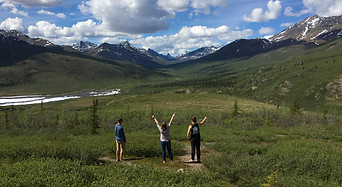
RESEARCH PROJECTS
Forest ecology research & restoration to support boreal forest conservation
As an Applied Vegetation Ecologist, I conduct and contribute to a variety of research and restoration projects that support inclusive boreal forest conservation solutions and inform policy. As part-researcher and part-restoration practitioner, I aim to ensure research projects address topical knowledge gaps that inhibit effective restoration practices; and that restoration projects are rooted in ecological research and theory. I study plant community successional dynamics following natural and anthropogenic disturbances, and practical restoration approaches that maximize ecological benefits and blend multiple perspectives and knowledge systems. I work with and for First Nations, governments, and a variety of engaged stakeholders. Learn more about what we do here.




Understanding where climate and species interactions shape species ranges is crucial to predict how species will respond to climate change. Theory predicts climate shapes cold limits, while species interactions shape warm limits as it is often assumed that herbivory intensity increases towards warm limits. However, climate can mediate the effect of species interactions, such as herbivory, on a focal plant species. For my PhD, I determined how temperature interacts with herbivory to shape demography across the range of Lupinus latifolius in the North Cascades, BC, Canada. Using integral projection modelling for a three-year field experiment manipulating temperature and herbivore access, I evaluated how temperature influences the impact of herbivory on population dynamics across the range. I found that the strongest effects of herbivory on population dynamics were towards warmer, lower elevations. Herbivory effects on populations were driven by a compounding effect of herbivory intensity and climatic stress, which together made plants more vulnerable to herbivory than either factor alone. Overall, findings suggest that unexpected species responses to climate change are partly explained by indirect effects of climate change, where climatic stress makes plants more vulnerable to herbivory. Manuscript in preparation but findings are in chapter four of my thesis here.
Temperature and herbivory as drivers of demography across species' ranges
.jpg)



(Left) Open-topped warming chambers and herbivore exclosures to determine how temperature and herbivory drive demogrgaphy across the species' range. (Top-Middle) Broadleaf lupine subalpine meadow in E.C. Manning Provincial Park, BC. (Bottom-Middle) Broadleaf lupine plants; photo by E. Menchions. (Right) Me installing an open-topped warming chamber; photo by J. Malloff.
Demographic lags and microclimatic buffering to explain species' range stasis
Ongoing climate change is causing many species' ranges to shift upslope to higher elevations. However, many species have not shifted in pace with recent warming (i.e., ‘range stasis’), possibly due either to demographic lags or microclimatic buffering. The ‘lagged-response hypothesis’ posits that range stasis disguises an underlying climatic sensitivity if range shifts lag the velocity of climate change due to slow colonization or mortality. Alternatively, the ‘microclimatic buffering hypothesis’ proposes that small-scale variation within the landscape, such as canopy cover, creates patches of suitable habitat within otherwise unsuitable macroclimates that create climate refugia and buffer range contractions. To test these two hypotheses, we combined a large seed addition experiment of 25 plant species across macro- and micro-scale climate gradients with local herbaria records to compare patterns of seedling recruitment relative to adult ranges and microclimate in the North Cascades, USA. We found support for the lagged response hypothesis, where adult ranges are in disequilibrium. Specifically, species' optimum shifted towards cooler regions and recruited beyond their cool edge. Meanwhile, we found trailing range dynamics are not limited by seedling recruitment. By contrast, we were unable to detect evidence of microclimatic buffering due to canopy cover. Combined, our results suggest apparent range stasis in our system is a lagged response to climate change at the cool ends of species ranges, with range expansions likely to occur slowly or in a punctuated fashion. Paper here!



(Left) Hiking in the North Cascades. (Centre) Viewpoint. (Right) Tagged seedlings in the seed addition experiment.
What stages of a species' life cycle drive range dynamics?
Species' respond in different ways to their environment throughout their life cycle. It remains unclear which parts of the life cycle are most important in shaping future climate-driven range shifts. For my M.Sc. with Dr. Carissa Brown, we looked at life-stage specific environmental requirements for black spruce (Picea mariana) at the northern range edge in Yukon. We identified strict microsite associations for successful seed production in adult trees and a lack of suitable substrates available for early recruitment at treeline. You can check out the paper here.





(Top Left) Gravel pit camping on the dempster highway, Yukon. (Bottom Left) Tombstone Territorial Park. (Centre) Black spruce seedling. (Top Right) Black spruce adult. (Bottom Right) Pingo in Tuktoyaktuk, NWT.